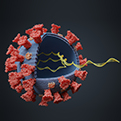
Getty Images / vchal
Spotlighting one of the first reports of an assay to diagnose SARS-CoV-2, Clinical Chemistry’s top five articles on COVID-19 in 2020 chronicle an extraordinary year of new tests and platforms to sleuth out this novel virus. These articles offered analysis, research findings and, in some cases, scrutiny of developing technologies.
The most-read article, Molecular Diagnosis of a Novel Coronavirus (2019-nCoV) Causing an Outbreak of Pneumonia, was published in January, long before SARS-CoV-2 was a systemic problem in the United States. Leo L.M. Poon, DPhil, developed two rapid real-time reverse transcription polymerase chain reaction (RT-PCR) tests that identify two gene regions of COVID-19, ORF1b and N. The tests each take an 1 hour and 15 minutes to run. “Diagnostic tests specific for this infection are urgently needed for confirming suspected cases, screening patients, and conducting virus surveillance,” said Poon, of the University of Hong Kong.
Matthew Binnicker, PhD, addressed these early testing efforts in China in his March opinion piece, Emergence of a Novel Coronavirus Disease (COVID-19) and the Importance of Diagnostic Testing: Why Partnership between Clinical Laboratories, Public Health Agencies, and Industry Is Essential to Control the Outbreak. Binnicker, PhD, director of clinical virology at Mayo Clinic, called for an adaptable infrastructure that would rapidly develop and deploy diagnostic tests that target diseases like SARS-CoV-2 and other diseases that pose a global threat.
“To provide healthcare providers with the answers they need to make critical patient-management decisions, rapid testing for the outbreak-associated pathogen is needed. This will require us to think creatively, so that testing for novel and emerging pathogens can be implemented in both public health laboratories and clinical laboratories in a timely fashion,” wrote Binnicker.
Two of the papers addressed potential weaknesses in the testing pipeline.
In a letter to the editor, Limits of Detection of 6 Approved RT–PCR Kits for the Novel SARS-Coronavirus-2 (SARS-CoV-2), researchers reported on the noticeable variations in limits of detections they found in commercial tests. Some of the poorer-performing kits led to false-negative results when RT-PCR was used to identify the virus. The authors advised that labs verify and compare performances from different kits and batches before using them routinely, and that manufacturers take steps to address problems and fine-tune their testing products.
Potential False-Negative Nucleic Acid Testing Results for Severe Acute Respiratory Syndrome Coronavirus 2 from Thermal Inactivation of Samples with Low Viral Loads examined how thermal inactivation might affect quantitative RT-PCR results, specifically with respect to specimens with low viral loads that produce false-negative results. Study authors looked at different specimen types and sample preservation times and investigated a chemical inactivation method on nucleic acid testing. While it had no significant impact on specimens with high viral loads, the investigators concluded that thermal inactivation on weak positive specimens “could be one of the possible causes of false-negative results in laboratory detection of SARS-CoV-2.”
Another top article reported success with a novel SARS-CoV-2 testing approach. Rapid Detection of COVID-19 Coronavirus Using a Reverse Transcriptional Loop-Mediated Isothermal Amplification (RT-LAMP) Diagnostic Platform explored the use of RT-LAMP technology to directly identify RNA. “This system can be coupled with a pH indicator present in the reaction mix to allow readout of the amplification reaction by change in color,” explained the researchers. Testing 248 samples from Chinese patients with COVID-19, they identified 89.9% (223/248) of samples with positive signals, using this platform.
Through early October, Clinical Chemistry and The Journal of Applied Laboratory Medicine had published 43 articles related to SARS-CoV-2. These papers address rigorous research, different testing methods, and related analyses as well as views and experiences of the global lab community in developing and implementing tests and in dealing with operational demands of the pandemic.
Collectively, this content as of early October had been downloaded more than 112,000 times, shared about 1,000 times, and cited in 220 other publications. Many of these articles have Altmetric Attention Scores in the top 5% of all research outputs, which indicate the reach and attention received by a publication beyond traditional methods of measuring impact. Both journals, in cooperation with Oxford University Press, have made COVID-19 content freely accessible to assist researchers, medical professionals, policymakers, and others who are working to diagnose, treat, and discover more about SARS-CoV-2.